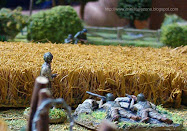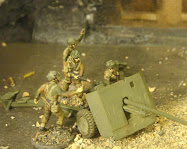
El I/IR7 alemán ataca la unidad rusa ubicada en este sector, el 1/366 rifle batallón logrando causar bajas que lo obligan a retirarse al este.
Strategy PC Games & World War II History Blog.




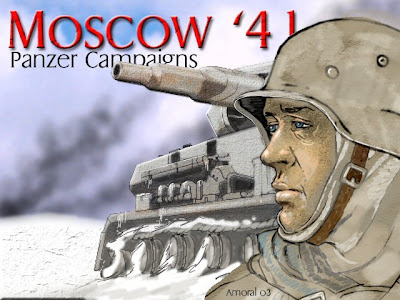
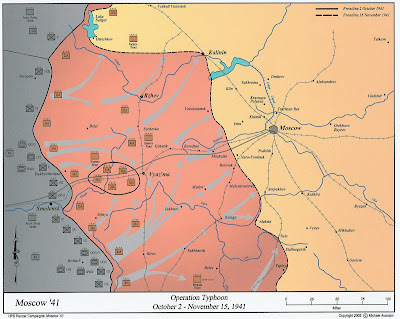


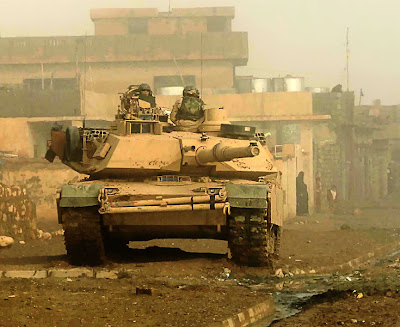
 Anti-tank refers to any method of combating military armored fighting vehicles, notably tanks. The most common anti-tank systems include artillery with a high muzzle velocity, missiles (such as wire-guided HEAT), various autocannons firing penetrating ammunition, and anti-tank mines.
Anti-tank refers to any method of combating military armored fighting vehicles, notably tanks. The most common anti-tank systems include artillery with a high muzzle velocity, missiles (such as wire-guided HEAT), various autocannons firing penetrating ammunition, and anti-tank mines.
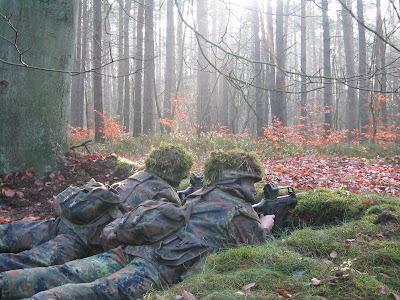 The Infantry is the oldest and most numerous of the Combat Arms in the armed forces, and consists of soldiers who predominantly fight on foot; an infantry soldier is an infantryman. Infantry units are the only types of land forces that can occupy and hold positions, and therefore have the most physically demanding training in the army, emphasizing physical fitness, physical strength, and aggressive character due to non-reliance on technology that augments marching all of which are required due to the primary role of the infantry to engage in ground combat.
The Infantry is the oldest and most numerous of the Combat Arms in the armed forces, and consists of soldiers who predominantly fight on foot; an infantry soldier is an infantryman. Infantry units are the only types of land forces that can occupy and hold positions, and therefore have the most physically demanding training in the army, emphasizing physical fitness, physical strength, and aggressive character due to non-reliance on technology that augments marching all of which are required due to the primary role of the infantry to engage in ground combat. Mountain guns are artillery pieces designed for use during mountain combat. They are similar to infantry support guns, and are generally capable of being broken down into smaller loads (for transport by horse, human, mule, tractor, and/or truck). Due to their ability to be broken down into smaller "packages", they are sometimes referred to as pack guns or pack howitzers.
Mountain guns are artillery pieces designed for use during mountain combat. They are similar to infantry support guns, and are generally capable of being broken down into smaller loads (for transport by horse, human, mule, tractor, and/or truck). Due to their ability to be broken down into smaller "packages", they are sometimes referred to as pack guns or pack howitzers.
 Self-propelled artillery (also called mobile artillery or locomotive artillery) vehicles are a way of giving mobility to artillery. Within the term are covered Self-propelled guns (or howitzers) and rocket artillery. They are high mobility vehicles, usually based on caterpillar track carrying either a large howitzer or other field gun or alternatively a mortar or some form of rocket or missile launcher. They are usually used for long-range indirect bombardment support on the battlefield.
Self-propelled artillery (also called mobile artillery or locomotive artillery) vehicles are a way of giving mobility to artillery. Within the term are covered Self-propelled guns (or howitzers) and rocket artillery. They are high mobility vehicles, usually based on caterpillar track carrying either a large howitzer or other field gun or alternatively a mortar or some form of rocket or missile launcher. They are usually used for long-range indirect bombardment support on the battlefield.

 Combat engineering is a combat service support role of using the knowledge, tools and techniques of engineering by troops in peace and war, but specifically in combat. A combat engineer, in many armies also called pioneer or sapper, is a military specialist in using the tools and techniques of engineering under combat conditions, who may perform any of a variety of tasks.
Combat engineering is a combat service support role of using the knowledge, tools and techniques of engineering by troops in peace and war, but specifically in combat. A combat engineer, in many armies also called pioneer or sapper, is a military specialist in using the tools and techniques of engineering under combat conditions, who may perform any of a variety of tasks. Militarily, reconnaissance is the active seeking to determine a foe's intentions by collecting and gathering information about an enemy's composition and capabilities along with pertinent environmental conditions, via direct observation, usually by scouts or military intelligence soldiers especially trained in critical surveillance
Militarily, reconnaissance is the active seeking to determine a foe's intentions by collecting and gathering information about an enemy's composition and capabilities along with pertinent environmental conditions, via direct observation, usually by scouts or military intelligence soldiers especially trained in critical surveillance A self-propelled anti-tank gun, or tank destroyer, is a type of armoured fighting vehicle designed specifically to engage enemy armor forces, and not produced for an infantry support role. Most have been traditionally defined and produced as a tank like vehicle with only light armor and capable of a higher transit speed, usually possessing high maneuverability whose main gun is not turret mounted and so cannot rotate horizontally.
A self-propelled anti-tank gun, or tank destroyer, is a type of armoured fighting vehicle designed specifically to engage enemy armor forces, and not produced for an infantry support role. Most have been traditionally defined and produced as a tank like vehicle with only light armor and capable of a higher transit speed, usually possessing high maneuverability whose main gun is not turret mounted and so cannot rotate horizontally.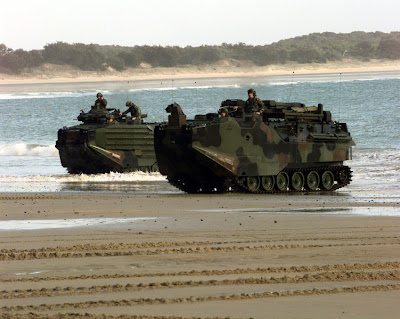 Amphibious warfare is the utilization of naval firepower, logistics and strategy to project military power ashore. In previous eras it stood as the primary method of delivering troops to non-contiguous enemy-held terrain. In this modern era amphibious warfare persists in the form of commando insertion by fast patrol boats, zodiacs and mini-submersibles.
Amphibious warfare is the utilization of naval firepower, logistics and strategy to project military power ashore. In previous eras it stood as the primary method of delivering troops to non-contiguous enemy-held terrain. In this modern era amphibious warfare persists in the form of commando insertion by fast patrol boats, zodiacs and mini-submersibles.
 An Air Assault is a tactical or operational manoeuvre of an infantry unit airlifted by helicopters, usually to fulfil an aerial envelopment role in a larger ground operation plan. The role of the assaulting force is rarely to immediately engage and destroy enemy forces, but rather to seize and hold key terrain. In addition to regular infantry training, these units usually receive training in rappelling and air transportation, and their equipment is sometimes designed or field modified to allow better transportation in helicopters. Due to the transport load restrictions of helicopters, air assault forces are usually light infantry though light tracked armored fighting vehicles like the Russian BMD-1, German Wiesel 1 and Swedish Bv206 designed to fit the heavy lift helicopters which enable assaulting forces to combine air mobility with a degree of ground mechanisation. Invariably the assaulting troops are highly dependent on aerial fire support provided by escorting armed helicopters or fixed wing aircraf
An Air Assault is a tactical or operational manoeuvre of an infantry unit airlifted by helicopters, usually to fulfil an aerial envelopment role in a larger ground operation plan. The role of the assaulting force is rarely to immediately engage and destroy enemy forces, but rather to seize and hold key terrain. In addition to regular infantry training, these units usually receive training in rappelling and air transportation, and their equipment is sometimes designed or field modified to allow better transportation in helicopters. Due to the transport load restrictions of helicopters, air assault forces are usually light infantry though light tracked armored fighting vehicles like the Russian BMD-1, German Wiesel 1 and Swedish Bv206 designed to fit the heavy lift helicopters which enable assaulting forces to combine air mobility with a degree of ground mechanisation. Invariably the assaulting troops are highly dependent on aerial fire support provided by escorting armed helicopters or fixed wing aircraf Paratroopers are soldiers trained in parachuting and generally operate as part of an airborne force.
Paratroopers are soldiers trained in parachuting and generally operate as part of an airborne force. The US has a distinguished history in mountain warfare, the 10th Mountain Division served in the Alps in WWII. The modern US military has several shortcomings in this area. Pakistani and Indian veterans of Kashmir who have attended the US Army Mountain Warfare School in Vermont and the US Marine Corps Mountain Warfare Training Center (MWTC) in Bridgeport, California have noted that while the US Military has excellent mountaineers, their Mountain Warfare skills fall short of expectations, [2]. The Marine Corps at the Mountain Warfare Training Center (6700ft - 14000ft) conducts individual skills and survival training as well as Marine Air/Ground Task Force MAGTF collective training as part of PTP for OEF-bound units. The U.S. Army does not conduct collective training in mountain warfare; it focuses more on individual survival training rather than high-altitude combat. [3]. These deficits were seen most glaringly during Operation Anaconda.
The US has a distinguished history in mountain warfare, the 10th Mountain Division served in the Alps in WWII. The modern US military has several shortcomings in this area. Pakistani and Indian veterans of Kashmir who have attended the US Army Mountain Warfare School in Vermont and the US Marine Corps Mountain Warfare Training Center (MWTC) in Bridgeport, California have noted that while the US Military has excellent mountaineers, their Mountain Warfare skills fall short of expectations, [2]. The Marine Corps at the Mountain Warfare Training Center (6700ft - 14000ft) conducts individual skills and survival training as well as Marine Air/Ground Task Force MAGTF collective training as part of PTP for OEF-bound units. The U.S. Army does not conduct collective training in mountain warfare; it focuses more on individual survival training rather than high-altitude combat. [3]. These deficits were seen most glaringly during Operation Anaconda.


 DESCARGA EL JUEGO EN ESTE LINK Y DISFRUTA AL MÁXIMO LA EMOCIÓN DE LA ESTRATEGIA DE LA SEGUNDA GUERRA MUNDIAL!
DESCARGA EL JUEGO EN ESTE LINK Y DISFRUTA AL MÁXIMO LA EMOCIÓN DE LA ESTRATEGIA DE LA SEGUNDA GUERRA MUNDIAL!

